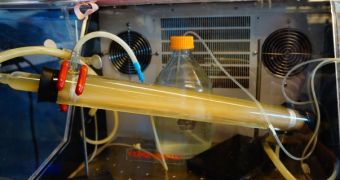In an attempt to improve water quality by better understanding how bacteria affect natural ecosystems, a graduate of the University of California, Riverside has built a working replica of the human colon.
What's more, Ian Marcus took up the habit of “feeding” his laboratory-made colon at least three times a day.
The goal was that of simulating human eating and analyzing how the process of breaking down food comes to affect the environment once digestion is done with.
The official website for the University of California, Riverside says that the system rolled out by this graduate student comprised not just the human colon replica, but also a septic tank and groundwater.
While carrying out his experiments, Ian Marcus focused on a pathogenic strain of E. coli and the microbial communities in which this pathogen typically lives.
His investigations led him to the conclusion that, when moving from the human colon to water treatment facilities and eventually to groundwater sources, bacteria behave differently than they do when studied in isolation inside laboratories.
His findings suggest that, contrary to what previous studies have shown, bacteria tend to linger for considerable amounts of time in natural ecosystems.
Because of this, they might constitute a threat to groundwater sources.
“Pathogenic bacteria are generally studied as a single strain under ideal growing conditions, although these conditions are not the norm in the environments in which pathogens typically proliferate.”
“The findings in this study clearly suggest that to gain insight into the fate of pathogens, cells should be grown and analyzed under conditions simulating those of the environment in which the pathogens are present,” Ian wrote in the abstract for his paper in the journal Applied Environmental Microbiology.
Professor Sharon Walker, who has had the chance to review Ian's work, says that this graduate student's findings shed new light on how bacteria behave when in the environment and might help roll out more efficient water treatment methods.
“Ian’s work has provided critical new insight into how microbial communities behave in wastewater treatment and contribute to biological contamination of water, which really changes the paradigm of how we do research and manage our water resources,” the professor said.

 14 DAY TRIAL //
14 DAY TRIAL //